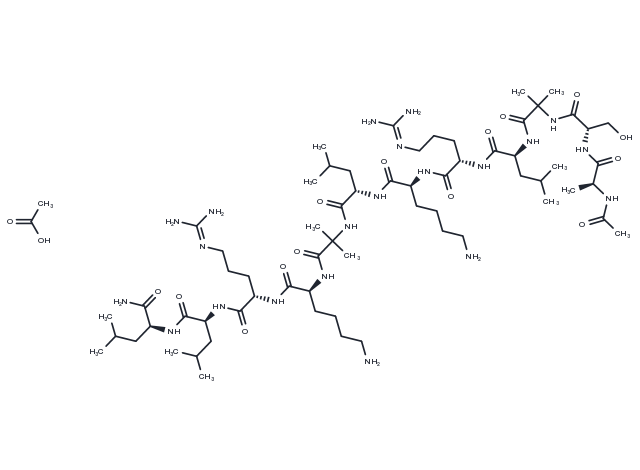keep away from moisture
Powder: -20°C for 3 years | In solvent: -80°C for 1 year

COG-1410 acetate is an apolipoprotein E-derived peptide and can be used in studies about neurological diseases.

| Pack Size | Availability | Price/USD | Quantity |
|---|---|---|---|
| 1 mg | In stock | $ 113.00 | |
| 5 mg | In stock | $ 297.00 | |
| 10 mg | In stock | $ 497.00 | |
| 25 mg | In stock | $ 793.00 | |
| 50 mg | In stock | $ 1,130.00 | |
| 100 mg | In stock | $ 1,520.00 | |
| 500 mg | In stock | $ 2,970.00 |

| Description | COG-1410 acetate is an apolipoprotein E-derived peptide and can be used in studies about neurological diseases. |
| In vitro | In BV2 microglia cells, COG-1410 acetate (1-25 μM; 48 h) decreases the production and release of NO and TNFα[3]. |
| In vivo | COG-1410 acetate (0.8 mg/kg; i.v.) improves vestibulomotor function, and decreases poststroke locomotor asymmetry, and infarct volume of the ipsilateral hemisphere in rats[1]. COG-1410 acetate (0.3-0.6 mg/kg; i.v.) exhibits significant improvement on a short-term test of vestibulomotor function and on a long-term test of spatial learning and memory in mice[3]. |
| Synonyms | COG-1410 acetate(878009-24-6 Free base) |
| Molecular Weight | 1468.83 |
| Formula | C66H125N21O16 |
keep away from moisture
Powder: -20°C for 3 years | In solvent: -80°C for 1 year
You can also refer to dose conversion for different animals. More
bottom
Please see Inhibitor Handling Instructions for more frequently ask questions. Topics include: how to prepare stock solutions, how to store products, and cautions on cell-based assays & animal experiments, etc.
COG-1410 acetate Apoptosis COG1410 Acetate COG 1410 Acetate COG1410 acetate COG 1410 acetate COG-1410 Acetate COG-1410 acetate(878009-24-6 Free base) inhibitor inhibit
